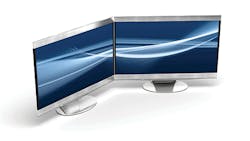Single- and Dual-Monitor Computer Setup: Ergonomic Tips
For many of us, our occupations almost entirely rely on the use of computers. Even though computers have provided great benefits to the workplace, they present ergonomic challenges.
| See Also: EHS Today eBook: Unlocking the Value of Safety Technology This eBook is a guide to implementing technology into your world-class safety processes. Download now. |
Here are some ergonomic tips for the setup and use of single- and dual- monitor computer workstations. Remember that in ergonomics, the objective is to fit the task to the worker and not the other way around.
Single-Monitor Setup
OSHA has developed the Computer Workstations eTool to provide a quick fix for computer workstations with a single monitor. OSHA's suggestions regarding monitor use target some of the most common ergonomic issues, helping to reduce the likelihood of injury to the neck.
Positioning the monitor – Depth and height of the monitor probably are the most commonly misunderstood variables. Although the recommendations have not changed to incorporate thin monitors, the use of thin monitors allows for more flexibility and ease of adjustment. To properly position a monitor, you should:
- Place the monitor directly in front of you.
- Ensure the monitor is at arm's length from you (18-28 inches).
- Position the top useable line of the monitor at a height where your neck is straight.
- Place the monitor at eye height for people who do not wear glasses or contacts or those who have single prescription lenses, and below eye height for people who wear bi-focals, tri-focals or progressive lenses.
The purpose of these suggestions is to keep your neck in a neutral posture, reduce eye strain and maintain good visibility. This especially is important when you spend many hours each day looking at your computer screen.
- Look away from your monitor every 20 minutes.
- Focus on something at least 20 feet away.
- Do this for at least 20 seconds.
OSHA calls this the 20/20/20 rule, for obvious reasons. The purpose of this exercise is to change the focus of your eyes, allowing the muscles in your eyes to relax and change from the otherwise constant focus.
Dual-Monitor Setup
The use of a dual-monitor computer workstation is becoming more popular in offices, as the computer becomes a more central feature of our workplace and paper documents primarily are transitioning to electronic media. Advice concerning the ergonomics of a dual-monitor workstation can be confusing.
As with a single-monitor workstation, the focus of ergonomic advice is on maintaining a neutral neck posture. This can present challenges when you are trying to look at another monitor, or switching frequently between monitors.
The proper setup of a dual-monitor computer workstation will depend on three factors:
- The percentage of use for each monitor;
- The type of work being performed; and
- Your dominant eye.
Before reading the following recommendations, think about how you use each of your monitors. Try to assess a percentage of usage and the type of work performed on each monitor. Do you use one monitor more than the other? Is one primarily used for data entry? Is one used primarily to reference documents?
Both monitors used equally (50 percent) – The first case to consider is when the monitors equally are used. In this situation, it is inevitable that some form of fairly frequent movement will have to occur to change between monitors. Ergonomic recommendations in this situation will be aimed at reducing the size of those movements:
- Position both screens as close as possible in front of you so that their inner edges are touching and are exactly in front of your nose.
- Angle the screens so that they are slightly concave, creating a semi-circle around you. This will ensure a consistent focal distance between you and the monitors.
- When facing the monitors, you should be at an arm's length away from them (18-28 inches).
- The top of both screens should be positioned so that your neck is straight (see previous section).
- When working for long periods of time on one monitor, use a swivel chair to physically turn to face that monitor, thus avoiding neck twisting. You should also re-orient your keyboard and mouse so that they are directly in front of the same monitor for the time period you are performing the single-monitor work.
- Apply the 20/20/20 rule to minimize fatigue.
The purpose of these recommendations is to implement the “standard” monitor setup (as described earlier), but in a dual-monitor situation. When changing views between both monitors, the movements away from “neutral” are minimized.
One monitor is the primary (>80 percent) – In this situation, we try to emphasize proper placement of the primary monitor (the one being used the most) as if it were a single-monitor workstation. The secondary monitor is placed beside the primary monitor on the side of the dominant eye at the same height and distance (concave around you). For the primary monitor, follow the steps described earlier for single-monitor setup. For the secondary monitor, place it on the side of your dominant eye.
To determine your dominant eye, perform the following steps:
- With your thumbs and index fingers at right angles, touch your index finger and thumbs together with your arms fully extended in front of you, making a diamond shape that you can look through. Alternatively, use a small tube like a toilet paper roll.
- Pick a light switch on the wall, sprinkler on the ceiling or some small object about 20 feet away from you.
- Focus on that object while looking through the diamond between your hands, with your arms fully extended in front of you.
- Alternately close one eye and then the other.
- You should see the object disappear when one of your eyes is closed.
- Your dominant eye is the one with which you can see the object through the diamond.
- While turned toward the secondary monitor, apply all the same principles as described earlier (e.g., facing it directly, arm's length away and align with eye height).
- Apply the 20/20/20 rule in the same fashion.
Most people with dual monitors lie along the spectrum between 50/50 use and 80/20 use. In those cases, the split of the monitors should be placed along an arc between right in the middle (as in the 50/50 use) and all the way to the side of the dominant eye (such as in the 80/20 use). The more the primary monitor is used, the closer to directly in front of you the split should be.
Jeffrey Fernandez, Ph.D., PE, CPE, is the managing principal at JFAssociates Inc., based in the Washington, D.C. area. He is a member of the EHS Today Editorial Advisory Board. Brandy Farris Ware, Ph.D., CPE, CSSBB, is an associate principal and technical director at JFAssociates Inc., based in the Phoenix area. Anand Subramanian, Ph.D., CPE, CSSBB, is an associate principal and office director at JFAssociates Inc., based in the Washington, D.C. area. Marc Christian, Ph.D., AEP, CSSBB, is an industrial engineer at JFAssociates Inc., based in the Washington, D.C. area.
About the Author
Anand Subramanian
Anand Subramanian ([email protected]) is a principal at JFAssociates Inc., based in the Washington, D.C. area. He holds a Ph.D. in industrial engineering from the University of Cincinnati, Ohio, and is a Certified Six-Sigma Black Belt, a Certified Professional Ergonomist, and an OSHA-30 certified professional.
Brandy F. Miller
Brandy Farris Miller ([email protected]) is a principal at Apex Ergonomics, based in the Phoenix area. She holds a Ph.D. in business organization and management and master's degree in industrial engineering with an emphasis in applied occupational ergonomics. She is a Certified Professional Ergonomist, Certified Six-Sigma Black Belt, an OSHA authorized 10/30 hour general industry outreach trainer, and is known for her expertise in the application of industrial engineering and applied occupational ergonomics principles in a wide variety of industrial settings.
Jeffrey E. Fernandez
Jeffrey Fernandez ([email protected]) is the managing principal at JFAssociates Inc., based in the Washington, D.C. area. He holds a Ph.D. in industrial engineering from Texas Tech University, is a registered Professional Engineer and a Certified Professional Ergonomist, is known for his expertise in occupational ergonomics and classical industrial engineering and is a member of the Editorial Advisory Board at EHS Today.
Marc Christian
Marc Christian, Ph.D., AEP, CSSBB, is an industrial engineer at JFAssociates Inc., based in the Washington, D.C. area.

